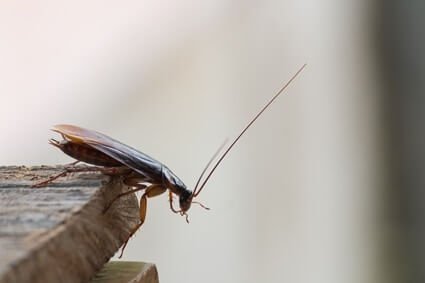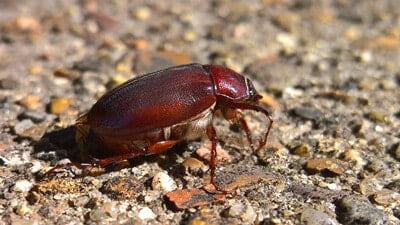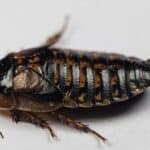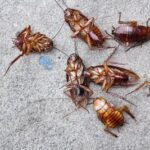Cockroaches prefer to live in temperatures that range from 25 to 40 degrees Celsius. This is the standard temperature for a U.S. home. If the room temperature drops below 25 degrees, cockroaches will vacate the premises in search of a warmer dwelling.
Cockroaches are cold-blooded and cannot regulate their internal temperature. Many will go into a state of hibernation called diapause if they can’t find somewhere warmer to live. If the temperature falls below 15° F, most cockroaches will die. In winter, roaches slow down to conserve energy and will reproduce at a slower rate.
Most homeowners would like to get some relief from cockroaches during the winter months. As human dwellings are kept at a reasonably warm temperature throughout cold weather periods, cockroaches can survive even the coldest winter seasons. Cockroaches that are outside and exposed to the cold will perish.
Where Do Cockroaches Go in The Winter?
Cockroaches are cold-blooded arthropods that cannot regulate their internal temperature. Though they are adaptable creatures, they can’t survive extreme temperatures. According to the University of Nebraska-Lincoln, cockroaches do not develop or reproduce when temperatures are too cold (below 45° F) or too hot (above 115° F).
Most species can’t survive when the temperature drops below 15° F. When winter approaches, most cockroaches will move indoors to stay warm. However, the cold weather affects cockroaches’ ability to reproduce and develop.
Many cockroaches enter a state of hibernation called diapause. This is a type of dormancy where cockroaches’ metabolic and growth rates slow down. As long as their chosen home has an abundance of food and water, they will continue to survive, albeit at a slower pace than during summer.
During the winter, cockroaches that live outside will enter hibernation. Most will sleep their way through winter, hiding under piles of woods, leaves, and mulch. Cockroaches can’t migrate during the colder months, so they need to find a warm hiding spot to survive. The most common hibernation spots are:
- Vents. Cockroaches sneak inside vents to gain access to warm homes.
- Decaying trees. Tree stumps or dying trees offer shelter from the cold, wind, and rain.
- Wood piles. American cockroaches, in particular, find refuge in piles of firewood nestling inside the cracks and gaps. They can get disturbed if the woodpiles are used throughout winter, making them a risky hiding spot.
- Walls and rafters. Cracks in walls offer access to drywall or warm insulation. They’re quiet and out of harm’s way.
- Chimneys. Not only can flying cockroaches get in through a chimney top, but they’re warm and have space.
- Kitchens. Cockroaches will hide down the back of kitchen cabinets to avoid detection. This also gives them access to food crumbs and liquids that seep through the gaps.
- Electrical appliances. You may find roaches in washing machines, cookers, microwaves, coffee machines, and more.
- Basements. Often the most humid part of the home, basements are an ideal hibernation space for cockroaches.
- Drains and pipes. Pipes and drains are full of moisture, attracting cockroaches looking for hydration.
Do Cockroaches Die in Cold Temperatures?
While most cockroaches can adapt to cold temperatures, most adult roaches will die if exposed to temperatures below 0° F. When the temperature reaches this low, they will struggle to survive and slowly perish unless they find a warmer place to live. Nymphs are more likely to go into hibernation.
Before they die from the cold, roaches will conserve their energy by limiting their daily activities. They’ll eat and move less, and reproduction will slow down. Instead, they’ll spend most of their time looking for a warm home.
Pest controllers use freezing to eliminate cockroaches. If roaches are placed into a sub-zero freezer, they’ll die within half an hour. Similarly, prolonged exposure to low temperatures will kill cockroach egg cases.
Though, this technique will only work when there’s a small or localized infestation. Large hordes can split off too easily and hide in other areas of the house.
Do German Cockroaches Hibernate?
Hailing from the warm climes of Southeast Asia, German cockroaches are susceptible to extreme temperatures. Studies suggest that when exposed to a temperature below 45° F, German cockroaches will die within 10 hours. If the temperature drops below 14° F, they will die within an hour.
Because of their inability to survive the cold, they live exclusively in and around human homes. Warmth is also essential for German cockroaches to reproduce. To conserve their energy during winter, German cockroaches reduce their activity levels by 75% and spend most of their time resting until the weather warms up.
However, if their chosen dwelling is warm enough and there is enough food and water for them, German cockroaches will continue to multiply and invade the home. This makes it challenging to remove infestations from the house.
German cockroaches enjoy temperatures of around 70° F, which is the standard temperature many homeowners keep their houses set to. Unfortunately, this invites cockroaches into the home, where they will thrive in the winter months.

Do American Cockroaches Hibernate?
The American cockroach is an outdoor species of roach that struggles to survive during the cold winter months.
In a journal published on ResearchGate, it’s explained how all American cockroaches studied during research died when air temperatures in a non-heated building reached below 0°C, despite having access to wood mulch substrate that remained above freezing.
Approximately 40% of American cockroaches died within 72 hours when exposed to temperatures of 8, 9, and 10°C. Mobility was also reduced, with the cockroaches becoming immobile over time. However, as the temperature increased, so did their survival and mobility rates.
The study suggests that American cockroaches could not survive for more than several days in temperatures lower than 10°C, meaning they wouldn’t even get the chance to find a spot to hibernate in. Freezing is also an effective control method for this species of cockroach.
However, if an American cockroach can find warmth in a pile of wood or inside a decaying tree, it will go into hibernation and may survive the winter. Many will look for a more pleasant temperature inside a human dwelling, where they will either remain active or diapause through the winter. Though, as a tropical species, they are unlikely to survive long enough to find refuge.
Do Oriental Cockroaches Hibernate?
Unlike most other roaches, Oriental cockroaches can survive freezing temperatures. While they are an indoor species, they will often venture outdoors in search of food. During the winter, they will hide under mulch, leaves, and stones.
However, when the temperature drops too low, they will move inside where it’s warmer. Oriental cockroaches like cool, dark places that they can crawl into, like basements, sinks, pipes, or drains. Oriental cockroaches are more tolerant of lower temperatures than others but will often find warmth inside rock walls.
They also need to be near water to survive but can live for up to a month without food and will barely eat if outdoors. This is what allows them to survive winter. Oriental cockroaches only reproduce once a year and rely on the winter months to do so.
Will Cockroaches Leave A Cold House?
Cockroaches don’t like the cold. If the environment is cold enough, they will leave in search of a warmer dwelling. They may not find one but remaining in a cold home is often not an option for the pests. Many houses have small gaps and cracks that provide enough warmth for cockroaches to survive, so they don’t need to search for another home.
However, some cockroaches can withstand colder temperatures and even adapt to them. As long as they have access to food and water, certain species will hibernate inside a colder home until it warms up again. Many cockroaches will also stay together in groups to keep their bodies warm.
What Season Do Cockroaches Come Out the Most?
When the temperature starts to warm up, cockroaches in hibernation begin to emerge in search of food and water. They can also sense humidity in the air and begin to reproduce and multiply quickly, leading to large-scale infestations inside the home.
Cockroaches are attracted to warm, humid areas and will flock to kitchens and bathrooms. Many cockroaches will also take refuge inside a warm home to get away from the intense outdoor heat, which is often too hot for cockroaches who prefer more moderate climates.
A house is an ideal place for cockroaches to inhabit. So, while cockroaches either die or tuck themselves away in winter, their populations flourish in the summer. This makes infestations challenging to control in the summer months.

How to Keep Cockroaches Away in Winter?
As cockroaches aren’t around so much in the winter, it would be easy to become complacent about pest control inside your home. But there’s still a chance that a lone cockroach could appear in your kitchen and bathroom, signifying you have a colony of hibernating cockroaches that will cause havoc when they re-emerge in the summer.
Therefore, prevention is vital. Follow these steps to stop cockroaches from getting inside the home during winter:
Keep Food Containers Sealed
Cockroaches can get into open bags, so keep food and leftovers in an airtight plastic container. Similarly, keep chilled food in the fridge – don’t leave it left out on the counter. Also, keep pet food stored safely in an airtight container where cockroaches can’t reach it.
Clean Up
Clean dirty dishes and cutlery immediately after use and put them away in their designated storage area. Wipe down kitchen counters and sweep all crumbs and food debris into a secure bin. Cockroaches can access even the smallest scraps of food, so give your kitchen a good spray down each evening.
Wash floors, removing dirt and debris, and scrub off food stains that cockroaches will be attracted to. Keep your living areas free from clutter, including piles of paper and clothes.
Remove Garbage
Don’t leave garbage lying around. If cockroaches can get inside your bin, they will have access to enough food to keep them sustained for a long time. Instead, replace your garbage bag every few days and clean out your trash can before replacing the bag.
Plug Gaps
Look for any cracks in your skirting boards and foundation and seal them up. Cockroaches love small gaps and crevices to hide away in, so blocking access will drive them elsewhere.
Similarly, plug up drains in the bathroom. Cockroaches can get inside the home through plumbing, so prevent access by blocking all plugs when they’re not in use.
When it comes to the cockroaches you need to look out for in the winter, German and American roaches are most likely to seek refuge inside the home. They don’t like the cold and are more likely to die during freezing temperatures. It’s only natural you’ll see a reduction in the number of cockroaches in winter compared to the summer.




